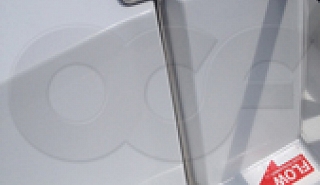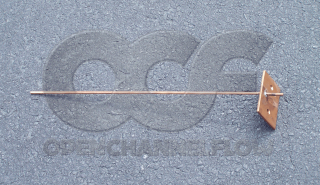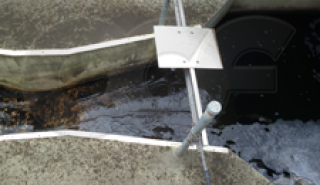Bubbler flow meters can be an excellent flow meter choice when measuring flows in flumes or weir boxes. They are unaffected by wind, foam, steam, and floating solids and provide a high level of measurement accuracy.
Adapting bubbler meters for use with flumes and weir boxes is straight forward using a stainless steel transition assembly.
How Bubbler Meters Work
Bubbler flow meters use either an internal air compressor or an external air tank to force air through a bubbler tube submerged in the flow stream. The depth of flow is determined by measuring the pressure needed to force bubbles out of the line. This depth is then converted into flow rate by the flow meter.

Bubbler meters are not affected by wind, foam, or turbulence in the flow stream. Also, as only the bubble line is in contact with the flow stream, bubbler meters are not susceptible to corrosive flow stream chemicals or floating oil / grease / debris.

As there are no parts to keep wetted, applications that periodically run dry (stormwater and seasonal flows) don’t present a problem for bubbler meters. Additionally, as temperature has little impact on the accuracy of the level measurement and the meter is unaffected by steam, applications that see wide or rapid temperature changes (laundries) also present no problem.

Bubbler meters continually reference their level reading with the atmospheric pressure – self-calibrating and reducing sensor drift over time. Uncalibrated, reading drift is typically 0.5% of reading per year.
Level accuracy for a bubbler meter is quite good - +0.005-feet [+/- 0.002 m] for levels up to 1-foot [0.31 m] deep.
Operationally, heavy silt and suspended solids can cause the need for periodic maintenance. High levels of grease can also be an issue – even with periodic purges or “super bubbles”.
Examples of bubbler flow meters include the OTT CBS, ISCO 4230 / Signature, and Hach Sigma 950
Using a Bubbler in a Flumes or Weir Boxes / Channels
After air is expelled from the bubbler meter, it travels through a flexible vinyl or Teflon bubbler line to the flume or weir. At the flume or weir box the flexible line is then attached to a rigid stainless steel bubbler line assembly.

The stainless steel assembly is bolted to top flange of the flume or weir box to ensure that the assembly does not move out of position either by accident or by debris is the flow stream. Additionally, a cavity is molded down the sidewall of the flume or weir box so that the assembly is exposed to, but not directly inline with the flow stream.
At the junction between the sidewall and floor of the flume / weir box where the stainless steel assembly is mounted, a depression is formed so that the opening of the assembly is below the floor of the flume / weir box – allowing the meter to read down to zero.

Standard flexible bubbler line size is 1/8-inch [0.3175 cm] (ISCO / Hach Sigma) or 3/8-inch [0.9525 cm] (OTT).
For smaller bubbler lines, the stainless steel bubbler assembly is provided with a 1/4-inch [0.635 cm] tube to reduce the likelihood of clogging by silt, suspended solids, oil, or grease. At the top, the tube is swagged – reducing the diameter to 1/8-inch [0.3175 cm] so that the flexible bubbler line can be pushed on. Swagging the stainless steel tube means that the assembly is airtight and cannot leak over time (as a compression coupling may). Additionally, the swagging process strengthens the top of the tube, making it considerably stronger than either a compression coupling or standard 1/8-inch [0.3175 cm] tube.
For larger bubbler lines, the stainless steel bubbler assembly is provided with a 3/8-inch [0.9525 cm] tube. The larger diameter tube means that the likelihood of clogging by debris or grease is greatly diminished. There is no need, therefore, for swagging the tube – the flexible bubbler line is pushed directly onto the assembly.





